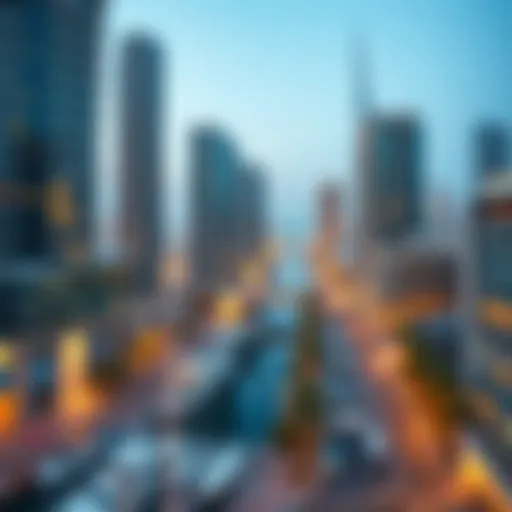The Al Sarraf Building: A Cultural and Architectural Gem
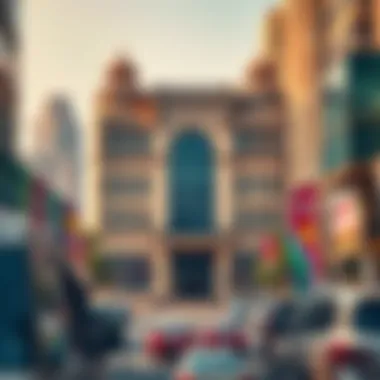

Intro
The Al Sarraf Building stands tall, not just as an architectural marvel in Dubai's ever-evolving skyline, but as a testament to the city’s cultural depth. With its unique design and strategic location, it invites scrutiny and appreciation from homeowners, visitors, planners, and architects alike. This building embodies a myriad of narratives that span history and modernity, illustrating the intricate relationships between architecture, culture, and community.
As we dive into the heart of this exploration, we will navigate through key sections detailing the building's surround, its landscape features, community elements, and the lively lifestyle that thrives around it. Such an understanding helps contextualize the Al Sarraf Building within Dubai's urban landscape, illuminating its multifaceted significance.
Neighborhood Features
Landscaping Highlights
The area surrounding the Al Sarraf Building is characterized by a harmonious blend of natural and urban landscapes. Landscaped parks envelop the structure, offering a green oasis amid the hustle and bustle typical of Dubai.
- The desert flora, carefully chosen, not only enhances the aesthetic appeal but also serves as a nod toward maintaining ecological sustainability.
- Walkways lined with palms and native plants create serene paths for pedestrians, offering a welcome respite from the city's fast pace.
- Water features, such as fountains and small ponds, can be found sprinkled throughout the landscaping, further enriching the atmosphere and engaging the senses. These elements not only beautify the area but also promote biodiversity, serving as habitats for local wildlife.
Architectural Styles
The design philosophy of the Al Sarraf Building reflects a dynamic fusion of contemporary and traditional styles. Drawing inspiration from Islamic architecture, it combines intricate geometrical patterns with modern materiality and advanced construction techniques.
- Key features, such as the mashrabiya screens, enhance both privacy and aesthetics, filtering daylight into vibrant play of shadows throughout the interiors.
- The use of glass and steel in combination with traditional stone cladding not only augments the visual appeal but also elevates the building's energy efficiency.
Such architectural choices highlight the juxtaposition of cultural heritage and modern innovation, creating an inviting environment for both residents and visitors.
Community Life
Local Events and Activities
The Al Sarraf Building serves as a nucleus for various community-driven events, promoting social ties and cultural experiences. From art exhibitions showcasing local talent to food festivals celebrating the diverse culinary landscape of Dubai, this venue is often buzzing with activity.
- Regular farmers’ markets offer residents a chance to engage with local producers, fostering a sense of community and support for sustainable practices.
- Cultural performances add a vibrancy to the area, showcasing the rich tapestry of traditions that coexist within this urban setting.
Lifestyle Amenities
Living around the Al Sarraf Building comes with its own set of lifestyle perks, making it an attractive location for many. The vicinity boasts a mix of leisure and convenience that enhances daily living.
- Homeowners can enjoy easy access to cafés and restaurants, offering diverse cuisines that cater to every palate.
- Fitness enthusiasts benefit from proximity to gyms and wellness centers, promoting a healthy lifestyle amidst the demands of urban living.
- Schools and educational institutions in the area make it a family-friendly neighborhood, drawing more residents seeking convenience and quality education.
In summary, the Al Sarraf Building is more than just a structure of bricks and mortar; it is woven into the fabric of community life in Dubai. Through thoughtful design and planning, it plays a pivotal role in enhancing local culture, connecting people, and fostering a rich urban dialogue.
Prelude to Al Sarraf Building
The Al Sarraf Building stands as a beacon of architectural ingenuity and cultural relevance in the heart of Dubai. Understanding this structure goes beyond merely appreciating its aesthetic appeal; it calls for a closer look at how it fits within the tapestry of urban life. This section emphasizes the significance of the Al Sarraf Building, shedding light on various aspects pivotal to both locals and visitors alike.
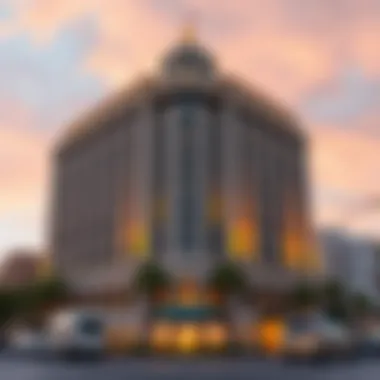

Location and Accessibility
Nestled within bustling areas, the Al Sarraf Building enjoys a prime spot that makes it easily accessible to a wide array of people. Positioned on Sheikh Zayed Road, a major artery in Dubai, it is by no means hidden from sight. Travelers can easily hop onto a public bus or hail a taxi, and within a matter of minutes, they find themselves in front of this architectural marvel. Nearby metro stations further contribute to the building's accessibility. This thoughtful location has not only facilitated foot traffic but has also made the building a hub of activity. Many locals frequent cafés and shops situated within the building, establishing a vibrant community environment.
Historical Overview
The historical journey of the Al Sarraf Building dates back to its inception, which reflects the ambitions of a rapidly developing city. Completed in the late 20th century, the building was envisioned at a time when Dubai was transitioning from a small trade center to a bustling metropolis. The construction involved meticulous planning and execution, with local artisans and international architects collaborating to create a unique identity that resonates with both heritage and modernity.
In the early days, the building primarily served as a commercial space, hosting a variety of businesses that contributed to the local economy. Over the years, it has become a landmark, often referenced in discussions about Dubai's architectural evolution. Notably, it mirrors the values of resilience and forward-thinking that characterize the emirate.
The Al Sarraf Building is more than just bricks and mortar; it is a testament to the spirit of Dubai — a place where tradition meets innovation.
As time marched on, the building has witnessed significant events that shape the community. It has been a venue for art exhibitions, cultural gatherings, and business meetings, reflecting its multifaceted role in society. This historical overview is essential for understanding not just the building itself but also the broader context of Dubai's architectural and cultural narratives.
Architectural Design
Architectural design serves as the backbone of any structure. It combines aesthetics with functionality to create spaces that resonate with people and communities. In the case of the Al Sarraf Building, its architectural design is not only about visually appealing structures; it reflects the rich cultural narratives of Dubai. This section unpacks the elements that make its architectural design significant, examining how these aspects influence local identity, the community's experience, and future developments in urban spaces.
Design Principles and Influences
At the core of Al Sarraf's design lies a blend of traditional and contemporary influences that not only pay homage to Dubai's rich heritage but also respond to modern needs. The architects employed principles of harmony, balance, and symmetry, drawing inspiration from both Islamic architecture and modernist design. This fusion reflects in the intricate façade, characterized by geometric patterns and graceful arches that invite closer inspection.
- Harmony with Nature: The design follows the landscape's contours, ensuring that the building does not disrupt the natural flow. Sliding terraces provide a connection to the outdoors, enhancing the aesthetic appeal.
- Cultural Reflection: Decorative elements reminiscent of Islamic calligraphy and motifs adorn many parts of the structure. This reinforces a sense of place and connects the building to its roots.
- Functional Spaces: The layout includes flexible room configurations. This adaptability is beneficial for community activities, exhibitions, and events, creating a multifunctional hub that supports various uses.
These design principles ensure that while the Al Sarraf Building stands tall and proud, it also communicates with various elements of its environment—an endeavor that seamlessly integrates culture with modern urban living.
Materials Used in Construction
The choice of materials in the construction of the Al Sarraf Building showcases not just aesthetics but also functionality, sustainability, and cultural significance. The careful selection speaks volumes about the craftsmanship and attention to detail that define the building.
- Local Stone and Marble: The use of locally sourced stone reflects a commitment to sustainability and a desire to connect with the heritage of the region. This decision also reduces the carbon footprint associated with transportation.
- Glass Elements: Large glass panels dominate the structure, offering a visual transparency that creates light and airy spaces. This choice blurs the lines between the interior and exterior, encouraging interaction with the surroundings.
- Eco-friendly Practices: Sustainable practices are embedded in the choice of materials. Products like recycled metals and environmentally friendly paints contribute to the building’s reduced environmental impact, aligning with Dubai’s goals for sustainable development.
The materials serve not only as functional building components but also symbolically underpin the narrative of Dubai as a place that honors the past while embracing the future.
Cultural Significance
The Al Sarraf Building stands as a unique testament to the evolving fabric of Dubai, embodying the interplay of history, culture, and architectural innovation. Its significance goes beyond mere bricks and mortar; it's a thread woven into the community’s identity. In this section, we will explore how the building not only shapes the surrounding environment but also resonates deeply with the people who inhabit this rapidly changing city.
Symbolism in Architecture
Architecture often serves as a mirror reflecting the values and aspirations of a society. The Al Sarraf Building is no exception, embodying symbols that resonate with locals and visitors alike. Its design incorporates elements that echo traditional Emirati styles while seamlessly blending with modern aesthetics. This duality not only honors the past but also embraces progress.
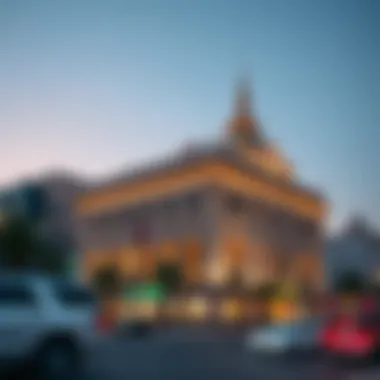

- Cultural Heritage: The intricate details and motifs found in the building's facade pay homage to regional arts and crafts. For instance, the mashrabiya windows symbolize privacy and modesty, key components of Emirati culture.
- Modern Resonance: The use of glass and steel in the building’s upper sections reflects Dubai's aspirations toward modernization and luxury. This dual-layered approach not only serves a practical function but tells a story of resilience and adaptation.
- Architectural Narratives: Every corner of the Al Sarraf Building whispers tales of the past and echoes the dreams of the future. It invites observers to ponder the journey of Dubai from a humble fishing village to a bustling metropolis.
"Buildings are a record of our past, a narrative that requires careful reading. The Al Sarraf Building tells a fascinating story of cultural amalgamation and historical continuity."
Community Engagement and Activities
The Al Sarraf Building plays a pivotal role in nurturing community engagement and fostering relationships among residents, business owners, and tourists. Its strategic location acts as a hub for various activities, making it an integral part of daily life in Dubai.
- Local Events: The building often serves as a venue for local art exhibitions and cultural festivals, bringing people together and promoting the richness of Emirati heritage. These events help strengthen community bonds and encourage artistic expression.
- Public Spaces: Thoughtfully designed common areas encourage social interaction. Benches, water features, and landscaping create an inviting atmosphere where people can gather, share stories, or simply enjoy the surroundings.
- Educational Initiatives: The building is active in hosting workshops and talks about architecture, sustainability, and cultural preservation. These initiatives aim to educate the next generation about the significance of their cultural legacy while promoting a sense of pride in their heritage.
The Al Sarraf Building thus transcends its physical form, acting as a cultural beacon that unites individuals and enriches their lives. It advocates for sustainable community practices while celebrating the arts and traditions that make Dubai unique.
The Impact of Al Sarraf Building on Local Identity
The Al Sarraf Building holds an exceptional place, not just in the skyline of Dubai, but also in the very fabric of the local identity. Its architectural lineage and the cultural narrative it embraces paint a vivid picture of a city that is continuously evolving. As such, understanding the impact of this building on the local identity unveils layers of social bonding, historical significance, and urban connection that outweigh its physical structure.
Defining Urban Space in Dubai
The Al Sarraf Building is more than mere concrete and glass; it's a piece of urban poetry that speaks to Dubai’s history and its aspirations for the future. Located in a bustling area, the building defines urban space through its innovative design and its functionality while blending seamlessly with the environment.
- Landmark Status: Its distinctive architecture gives a sense of place, marking the area on the map for both residents and tourists.
- Civic Function: Beyond being a commercial structure, it hosts significant community events, acting as a hub where business and social life intertwine.
- Navigational Aid: The building serves as a reference point for locals and visitors alike, helping to navigate the sometimes overwhelming urban layout of Dubai.
The significance of such contributions becomes apparent when considering how they forge connections among community members, filling the spaces around the building with life and purpose.
Integration with Surrounding Areas
The integration of the Al Sarraf Building into its surrounding urban context is a remarkable aspect of its impact on local identity. This building does not exist in a vacuum; rather, it interacts dynamically with the community and environment around it.
- Architectural Harmony: Al Sarraf's design conforms to the architectural themes present in nearby structures, fostering a cohesive aesthetic that enhances the overall visual appeal of the district.
- Accessibility: The strategic positioning of the building prioritizes access, promoting foot traffic that contributes to local businesses and encourages community interactions.
- Cultural Events: Collaboration with local organizations for events transforms the surrounding area into a vibrant marketplace of ideas, art, and culture.
Environmental Considerations
Understanding the environmental considerations surrounding the Al Sarraf Building is essential for grasping its architectural significance and cultural relevance. This aspect highlights how architecture can intertwine with ecological sustainability while catering to community needs. In this section, we will explore sustainable design practices and the role of green spaces in enhancing the building's environmental footprint and its connection with the surrounding landscape.
Sustainable Design Practices
Sustainable design practices are more than a trend; they are becoming integral to modern architecture, reflecting a growing awareness of environmental issues. The Al Sarraf Building stands as a testament to these practices in several ways.
- Energy Efficiency: One notable aspect of its design is the incorporation of energy-efficient systems, which aim to minimize energy consumption. This not only lowers operational costs but also reduces the building’s carbon footprint. For example, the use of high-performance glass allows natural light to flood the interior while significantly decreasing the need for artificial lighting.
- Water Conservation: Another critical practice is the implementation of water conservation strategies. The designers have opted for low-flow fixtures and a rainwater harvesting system. This approach not only helps in managing resources more efficiently, but also demonstrates a commitment to sustainable living, encouraging occupants to be more mindful of their water usage.
- Material Selection: Thoughtful choices in materials also play a crucial role—prioritizing recycled or locally sourced materials can drastically reduce the environmental impact. Al Sarraf Building's structure incorporates materials that promote ventilation and thermal comfort while sustaining the area's authenticity.
"Sustainable design is a mindset that encourages not just the consideration of environmental impacts, but also the enhancement of life quality for all community members."
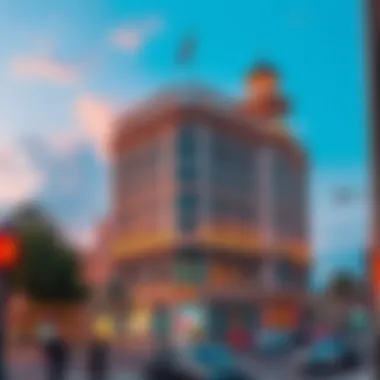

Green Spaces and Landscaping
In the bustling heart of Dubai, the integration of green spaces around the Al Sarraf Building is a breath of fresh air. These areas fulfill various roles that extend beyond mere aesthetics.
- Biodiversity Support: Landscaping is targeted at supporting local biodiversity, incorporating native plants that thrive in the region's climate. This approach not only conserves water but also provides habitats for local wildlife, thereby enriching the urban ecosystem.
- Community Spaces: Green spaces often serve as communal hubs where residents and visitors can gather, relax, and engage in outdoor activities. The landscaped areas around Al Sarraf offer shaded spots, walking paths, and seating zones, fostering a sense of community amidst the urban setting.
- Visual Appeal: Additionally, these green areas enhance the overall visual appeal of the Al Sarraf Building. A well-thought-out landscape not only complements the architecture but also contributes to improved mental well-being for people who frequent the area. Studies suggest that being in proximity to nature can reduce stress and enhance mood.
Through these environmental considerations, the Al Sarraf Building not only stands as an architectural landmark but also as a vital promoter of sustainability and community engagement. Its design and landscaping intricately weave together the building’s identity with that of Dubai, setting a commendable example for future developments.
Future Prospects for Al Sarraf Building
The future of the Al Sarraf Building holds significant promise, not just as a physical structure, but as a vital pillar for the community and urban landscape of Dubai. As trends in architecture and urban development evolve, so too does the necessity for this building to adapt and thrive within an ever-changing cityscape. The importance of this topic lies in understanding how the building can continue to function as a cultural and historic beacon while also addressing modern demands. Below, we delve into two core aspects of its future: proposed renovations and upgrades, and its role within broader urban development plans.
Proposed Renovations and Upgrades
Renovations are often needed to breathe new life into historical structures. The future of Al Sarraf Building could include upgrades that not only enhance aesthetic appeal but also incorporate modern functionalities. Consider the following:
- Restoration of Original Features: Efforts should focus on rejuvenating its historical aspects, ensuring that the building retains witout losing its charm.
- Incorporation of Innovative technologies: Smart building technologies could be integrated to improve energy efficiency and visitor experiences. Example includes energy-efficient lighting and climate controls.
- Adaptable Spaces: Modifying areas to host community events or exhibitions can make the space more versatile and relevant to current needs.
"Adaptive reuse can bridge the past and future, creating a narrative that resonates with contemporary audience."
These upgrades not only align the building with modern sustainability practices but also affirm its role as a community hub, enhancing its ongoing relevance.
Role in Urban Development Plans
In the grand tapestry of urban development in Dubai, the Al Sarraf Building is positioned to play an influential part in shaping the direction of future projects. This hinges on a few critical factors:
- Integration with Transport Networks: As public transportation improves in the city, the Al Sarraf Building’s accessibility could be a focal point. Amplifying its connection to bus routes, metro stations, or pedestrian pathways will escalate its foot traffic and visibility.
- Fostering Local Markets: Urban development should reflect local culture and businesses. The building can serve as a catalyst to promote local artisans and entrepreneurs through markets or pop-up events, thereby fostering economic growth.
- Collaboration with Urban Planners: Ensuring that the building aligns with long-term goals for pedestrian spaces and green design will maintain its relevance in a cluttered urban environment. A strategic partnership with planners can also facilitate projects that honor community traditions while addressing modern needs.
Overall, as Dubai positions itself for the future, the Al Sarraf Building holds a promising prospect of not only surviving but flourishing. Its significance as a cultural landmark will undoubtedly be enhanced by thoughtful renovations and a strategic role in broader urban planning initiatives.
Finale
The Al Sarraf Building stands as more than just a prominent structure in Dubai; it encapsulates the rich interplay between architecture and culture. Its architectural significance emerges from a unique blend of historical context, innovative design, and community integration. Throughout this article, we explored the intricate layers that define the Al Sarraf Building, revealing how it reflects the aspirations and lifestyle of the urban landscape of Dubai.
Summation of Key Insights
To summarize, the following key insights emerge from our examination:
- Architectural Design: The Al Sarraf Building showcases a harmonious blend of traditional and modern design elements, rooted in the cultural heritage of its surroundings. Its unique features make it a landmark that attracts both locals and tourists.
- Cultural Relevance: The structure serves as a cultural hub, actively engaging with the community through various activities and events. It strengthens communal bonds, making it a vital part of Dubai's identity.
- Environmental Considerations: Efforts to integrate sustainability in construction highlight the building's role not only as a physical space but also as a model for future developments in urban planning.
- Future Prospects: Proposed upgrades promise to enhance its functionality and relevance, keeping pace with the evolving urban fabric. This adaptability is crucial in maintaining its status as a cultural touchstone.
Each of these facets reinforces the idea that the Al Sarraf Building is a living entity, changing with the community and environment around it.
Final Thoughts on Cultural Impact
As urban spaces continue to develop and grow, structures like the Al Sarraf Building serve as reminders of the importance of cultural relevance in architecture. They inspire new generations to both respect tradition and embrace innovation, ensuring that the essence of Dubai's rich heritage remains alive in the modern skyline.
"Architecture is not just about buildings. It reflects the heart of a community that shapes and is shaped by its surroundings."
Ultimately, stakeholders, including architects, urban planners, and community members, should recognize the value of preserving such structures, ensuring they continue to impact future generations.

